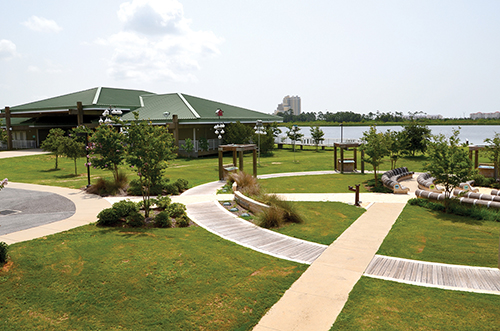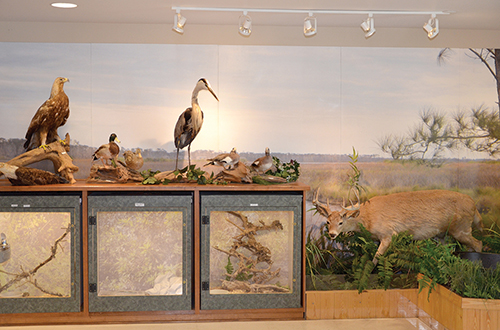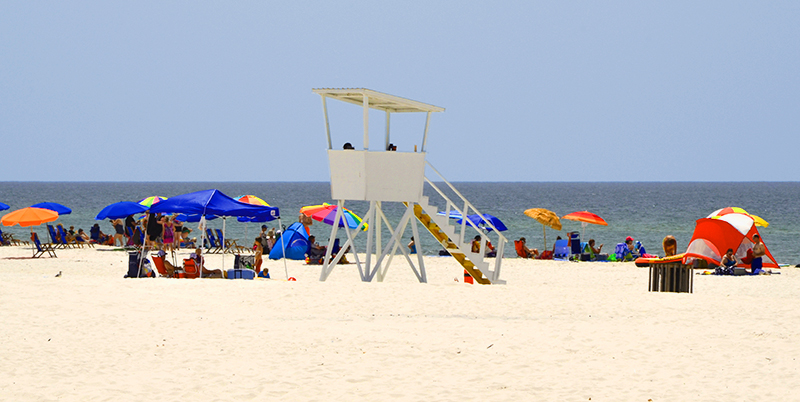By John N. Felsher
A decade ago, Hurricane Ivan slammed ashore on the Gulf Coast, packing nearly 130 mile per hour winds. Early on the morning of Sept. 16, 2004, the monster about the size of Texas scored a direct hit on Gulf State Park, causing considerable damage.
“People came down from other parks to help,” recalls Kelly Reetz, who began working at the park in 2000. “While most people were heading north, park employees were heading south. Getting ready for Hurricane Ivan, we worked so hard getting everything off the beach and securing the facilities as best we could, but we still had a lot of damage.”
Ten years later, scarred trees remind visitors of that terrible day, but the park recovered quickly at the time, repairing and rebuilding facilities. Over the years, the park also added facilities not there in 2004, such as a zip line for guests. Today, the park occupies 6,180 acres of prime real estate on the Gulf of Mexico between the towns of Gulf Shores and Orange Beach.
“We’re one of the most popular parks in Alabama all year long,” explains Lisa Laraway, superintendent of Gulf State Park and the Southwest District. “We get people who come here from all over the country, particularly in the winter. Some people from northern states and Canada stay all winter. Most people come here for the beach, but we have plenty of reasons for people to visit here.”
 The park includes more than 3.5 miles of sugar-white beaches along the Gulf shoreline, often considerably less crowded than adjacent beaches in either Gulf Shores or Orange Beach. For those who want a break from the sand, the Beach Pavilion offers beachgoers picnic tables in the shade, a seasonal concession stand and air-conditioned bathrooms with showers. Parties can also book the pavilion for weddings, beach parties, reunions or other functions.
The park includes more than 3.5 miles of sugar-white beaches along the Gulf shoreline, often considerably less crowded than adjacent beaches in either Gulf Shores or Orange Beach. For those who want a break from the sand, the Beach Pavilion offers beachgoers picnic tables in the shade, a seasonal concession stand and air-conditioned bathrooms with showers. Parties can also book the pavilion for weddings, beach parties, reunions or other functions.
Also unique among Alabama state parks, the Gulf State Park Pier extends 1,540 feet, or more than a quarter mile, into the Gulf of Mexico. Ivan severely damaged the pier in 2004, but the rebuilt structure opened in July 2009. It now offers anglers about 41,800 square feet, including 2,448 feet of fishing space along the rails. Special removable panels allow the sea to blow through holes in the pier while leaving the concrete supports intact.
“Living right on the Gulf Coast, we are prepared for hurricanes,” Laraway said. “When the pier was rebuilt, the decking was made in sections so it could be picked up and removed. We removed the panels when Hurricane Isaac hit in 2012. It’s a good thing we did, because the water went over it. It took about a week to get it back in operation, but it had much less damage than when Ivan hit.”
The pier also contains fish-cleaning stations where anglers can prepare their catch. At the shore end of the pier, patrons may sample barbecue and other restaurant specialties as sea breezes cool them. They can also stop in the store to purchase supplies and refreshments or even rent fishing gear.
The largest pier on the Gulf Coast remains open for fishing 24 hours a day all year long. Anglers must possess a pier fishing permit and a state saltwater license to fish on the pier. To save a few dollars, sportsmen can purchase a special state pier license instead of the saltwater license. In addition, anglers can buy a daily, monthly, semi-annual or annual pier fishing permit. Non-fishermen pay a small sightseeing fee to go out on the pier.
“I’ve been fishing the pier since I was old enough to drive about 40 years ago,” said David Thornton, an area sportsman. “People catch just about every type of saltwater fish off the pier. We catch a lot of big bull reds. They also catch Spanish mackerel, jack crevalle and other fish. Occasionally, someone even catches a tarpon. Pier anglers just can’t fish for sharks. If anglers hook sharks, they must cut their lines. The park staff doesn’t want people fishing for sharks so close to the swimming beach.”
Besides offering an excellent place where anglers without access to boats can catch large fish, the pier exists as an educational facility. Placards along the rails provide information about the fish species, birds and other creatures that live in the area. Some at the cleaning station even explain fish anatomy.
“Each week, depending upon the weather, we give guided pier walks, by far our most popular nature program,” Reetz advised. “Guests have an opportunity to see fish being caught and learn about different types of fish, birds, crustaceans, shells and marine mammals. Sometimes we get lucky and see huge schools of fish or some dolphins. We might see fish herding bait into a ball and birds attacking the baitfish from the air.”
Although anglers can fish the Gulf for salty fish, they can also explore three natural spring-fed freshwater lakes north of the beach. Connected by canals, Little Lake, Middle Lake and Lake Shelby total about 900 acres. The largest, Lake Shelby, spreads across about 750 acres. They average about four feet deep, but some holes in Lake Shelby drop to about 18 feet deep. Anglers may launch their own boats into the lakes or rent canoes from the park.
“They are freshwater lakes, but they connect to the salt marshes and Little Lagoon,” explained Randy Stultz, one of the park managers. “Salt water from prior hurricanes got into the lakes and mixed with the fresh water. Now, anglers can catch largemouth bass, redfish, crappie, speckled trout, flounder and other fish in them. I’ve even seen mangrove snapper and tarpon come out of the lakes.”
Along the lakes, campers may erect tents or park recreational vehicles at nearly 500 improved campsites complete with water, sewer and electrical hook-ups. Open seven days a week, the camp store sells items campers need. Patrons may also find souvenirs, shirts, coffee mugs, or even buy items to make minor repairs on recreational vehicles.
Overnight guests may also rent 11 three-bedroom cottages that overlook Lake Shelby. Cottages come equipped with modern conveniences such as full kitchens complete with utensils, dishes, flatware, microwaves, coffee pots, toasters and dishwashers. The park also rents more than 20 similarly equipped cabins including some on the lake and others in secluded in pine forests. Visitors may bring their pets when staying in the woods cabins. Two lakeside cabins are handicapped accessible.
For those who want to golf on the Gulf, the Refuge Golf Course offers 18 holes in picturesque beauty amidst the oaks. The golf course stays open seven days a week. After swinging clubs, golfers may wish to visit the Refuge Grill in the pro shop for a delicious sandwich or other refreshments. Some golfers start their day with a breakfast at the grill.
Miles of trails to see wildlife and nature
 Many nature enthusiasts enjoy hiking or biking on miles of trails. Named for a former park superintendent, the Hugh S. Branyon Backcountry Trails wind through marshes, pine forests, oak hammocks and other habitats. The Oak Ridge Trail wanders behind the golf course. The Rosemary Trail runs south of Middle Lake and Little Lake before hitting the beach road. Created after Hurricane Frederic hit the Gulf Coast in 1979, the Hurricane Ridge Trail follows a natural ridge built by the storm tidal surge.
Many nature enthusiasts enjoy hiking or biking on miles of trails. Named for a former park superintendent, the Hugh S. Branyon Backcountry Trails wind through marshes, pine forests, oak hammocks and other habitats. The Oak Ridge Trail wanders behind the golf course. The Rosemary Trail runs south of Middle Lake and Little Lake before hitting the beach road. Created after Hurricane Frederic hit the Gulf Coast in 1979, the Hurricane Ridge Trail follows a natural ridge built by the storm tidal surge.
“While most people come here for the beaches, we have more than just beaches,” Reetz emphasized. “We also have salt marshes, lakes and different forest habitats. We have many different types of wildlife including deer, bobcats, raccoons, lots of alligators and other reptiles. Many migratory birds come through in April and October. Endangered Kemp’s ridley sea turtles sometimes nest on our beaches. We also have endangered Alabama beach mice.”
While many people like to explore nature on their own, others take guided tours. As the park naturalist, Reetz leads diverse adventures including the pier walk and other nature programs to introduce people to the types of wildlife that inhabit southern Alabama. People can also visit the Nature Center, a living museum with many exhibits including both live and stuffed animals.
“At Nature Time at the Nature Center, we take the animals out for children to see them and touch them,” Reetz said. “We have nature programs all year long. On guided nature walks, we meet people at different places and talk about the plants and animals we see. We always see something different. The trails stay very busy. In the winter, visitors from up north love to get on their bicycles and ride all over the place.”
Whether zipping down a line over a lake, dropping a line off the pier, biking along a trail or just absorbing the sun on the beach, one of the most popular parks in Alabama offers something for just about everyone. For more information on Gulf State Park, see www.alapark.com/gulfstate. For reservations, call 800-ALAPARK (800-252-7275).





